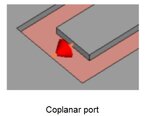realfanta
Newbie level 4
I'm now try to calculate grounded CPW impedance using CST. I added waveguide port according to tutorial section 'Wveguide Port Overview'.
If the port is in boundary plane (shown in fig1), port mode shows normal QTEM mode and the calculated impedance is accurate.
However, if the port is located internally, means the port is within boundary (shown in fig2), the results are totally wrong.


Boundary condition is shown in fig3.
Can anybody teach me where I'm wrong? Does it imply that waveguide port must locate in boundary plane?
BTW: Is discrete port OK to use to calculate such kind of waveguides? How to set discrete port for CPW internal port?
Thanks.
If the port is in boundary plane (shown in fig1), port mode shows normal QTEM mode and the calculated impedance is accurate.
However, if the port is located internally, means the port is within boundary (shown in fig2), the results are totally wrong.
Boundary condition is shown in fig3.

Can anybody teach me where I'm wrong? Does it imply that waveguide port must locate in boundary plane?
BTW: Is discrete port OK to use to calculate such kind of waveguides? How to set discrete port for CPW internal port?
Thanks.
Last edited:


